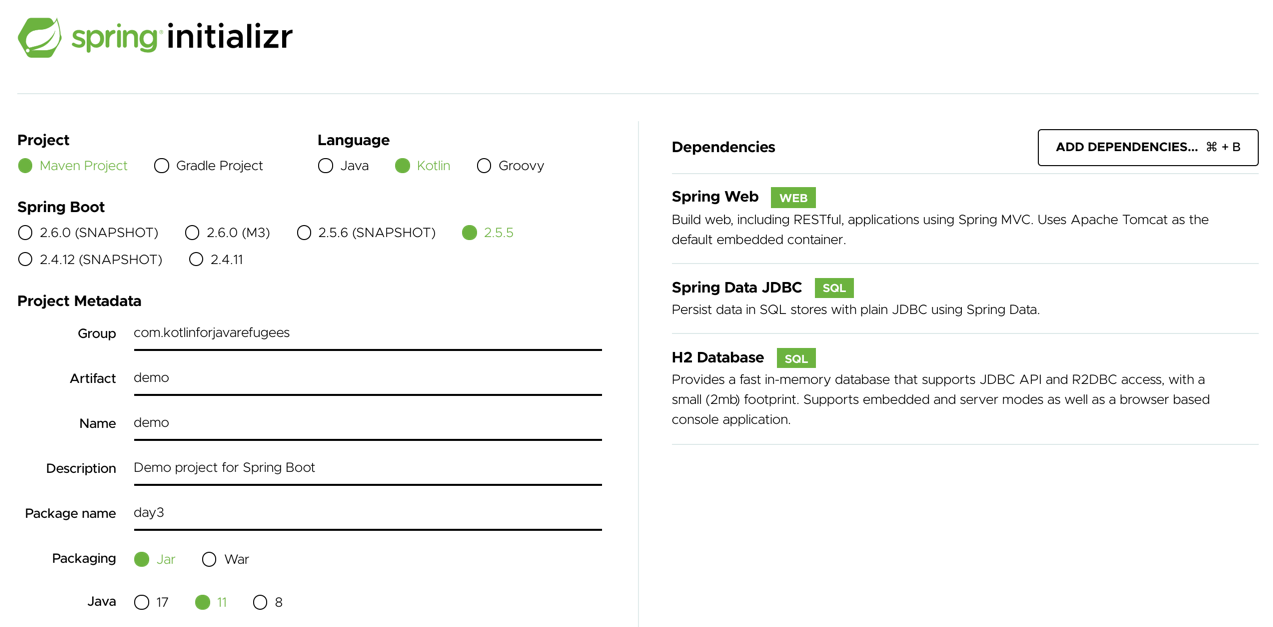Day 3 - Spring in Kotlin
Challenge - create a SpringBoot app
- Create a SpringBoot application from scratch
- Use Spring Initializr or directly from IntelliJ

- Add “Spring Web” / “Spring Data JDBC” / “H2 Database”

- Use Spring Initializr or directly from IntelliJ
Observe the pom.xml
- What is different from what you are used to ?
<sourceDirectory>${project.basedir}/src/main/kotlin</sourceDirectory> <testSourceDirectory>${project.basedir}/src/test/kotlin</testSourceDirectory> <plugins> <plugin> <groupId>org.springframework.boot</groupId> <artifactId>spring-boot-maven-plugin</artifactId> </plugin> <plugin> <groupId>org.jetbrains.kotlin</groupId> <artifactId>kotlin-maven-plugin</artifactId> <configuration> <args> <arg>-Xjsr305=strict</arg> </args> <compilerPlugins> <plugin>spring</plugin> </compilerPlugins> </configuration> <dependencies> <dependency> <groupId>org.jetbrains.kotlin</groupId> <artifactId>kotlin-maven-allopen</artifactId> <version>${kotlin.version}</version> </dependency> </dependencies> </plugin> </plugins>
Open classes in Kotlin
- In Kotlin, all classes are final by default
- If you compile this
class Try class Success : Try() - The compiler will fail :
Kotlin: This type is final, so it cannot be inherited from - To make a class open for extension, we should mark that class with the open keyword :
open class Try class Success : Try()This behavior can be problematic in Spring applications : some areas in Spring only work with non-final classes.
- If you compile this
- The natural solution is to manually open Kotlin classes using the open keyword or to use the kotlin-allopen plugin
- Which automatically opens all classes that are necessary for Spring to work
<dependency> <groupId>org.jetbrains.kotlin</groupId> <artifactId>kotlin-maven-allopen</artifactId> <version>${kotlin.version}</version> </dependency> - Know more about this plugin here
Analyze code structure
- How does it differ from what you are used to ?
- Open the
DemoApplication.ktfile- What do you notice ?
runApplication<DemoApplication>(*args)
- No worries this is not a pointer 😜
*is called the spread operator- Allowing us to call a function taking a vararg with an array
- We just have to prefix the array with the operator
fun <T> asList(vararg ts: T): List<T> { val result = ArrayList<T>() for (t in ts) // ts is an Array result.add(t) return result } val list = listOf(1, 2, 3) // If you want to pass a primitive type array into vararg, you need to convert it to a regular (typed) array using the toTypedArray() function: asList(*list.toTypedArray())
- No worries this is not a pointer 😜
- What do you notice ?
Create a message Controller (RestController)
- Return a hardcoded list of Message on
GET - A message is composed by an id (String nullable) and a text
@RestController
class MessageController {
@GetMapping
fun findMessages(): List<Message> = listOf(
Message("1", "Moi, à une époque, je voulais faire vœu de pauvreté (...) Mais avec le pognon que j'rentrais, j'arrivais pas à concilier les deux."),
Message("2", "Au bout d'un moment, il est vraiment druide, c'mec-là, ou ça fait quinze ans qu'il me prend pour un con ?")
)
}
data class Message(val id: String?, val text: String)
Run your application and test your Rest Controller through
PostmanorIntelliJ
Add the missing Layers
- Create a Service that will contain 2 functions
findMessages/addMessage- Put a TODO in the addMessage function for now
@Service class MessageService { fun findMessages(): List<Message> { TODO() } fun addMessage(message: Message) { TODO() } }
- What else do we need to do ?
Add the Database / repository
- This Service needs a Repository to retrieve the data
- Create it
interface MessageRepository: CrudRepository<Message, String> { @Query("SELECT * FROM messages") fun findMessages(): List<Message> }
- Create it
- Make our POKO representing a Table
- Add
@Tableannotation and@Idon our id@Table("MESSAGES") data class Message(@Id val id: String?, val text: String)
- Add
Plug everything together
- Use our repository in our Service
- Finalize our Service implementation by saving the Message
@Service class MessageService(private val repository: MessageRepository) { fun findMessages(): List<Message> { return repository.findMessages() } fun addMessage(message: Message) { repository.save(message) } }
- Finalize our Service implementation by saving the Message
- Can be simplified by using
IntelliJfeature :
@Service
class MessageService(private val repository: MessageRepository) {
fun findMessages(): List<Message> = repository.findMessages()
fun addMessage(message: Message) = repository.save(message)
}
- Use our Service in our Controller
@RestController class MessageController(private val messageService: MessageService) { @GetMapping fun findMessages(): List<Message> = messageService.findMessages() } - Add the mapping to be able to create new messages
@PostMapping fun addMessage(@RequestBody message: Message) = messageService.addMessage(message)
Configure the database
- Add an
application.propertiesfilespring.datasource.driver-class-name=org.h2.Driver spring.datasource.url=jdbc:h2:file:./data/testdb spring.datasource.username=sa spring.datasource.password=password spring.datasource.schema=classpath:sql/schema.sql spring.datasource.initialization-mode=always
Add the init script
- In the
application.propertieswe set the schema tosql/schema.sql- Create this file that initializes the db schema
CREATE TABLE IF NOT EXISTS messages ( id VARCHAR(60) DEFAULT RANDOM_UUID() PRIMARY KEY, text VARCHAR NOT NULL );
- Create this file that initializes the db schema
Use our favorite mapper (MapStruct)
- In real life we would not expose our Entities directly from our Controller
- Let’s add a decoupling layer
- Change the public contract :
- Pass a
AddMessagecommand in the POST and return aMessageDtoin the GET
- Pass a
// Do not pass the id -> auto-generated by our db
data class AddMessage(val text: String)
// id no more nullable
data class MessageDto(val id: String, val text: String)
- Create our
MessageMapperto map :- AddMessage -> Message
- Message -> MessageDto
@Mapper
interface MessageMapper {
fun convertToEntity(command: AddMessage): Message
fun convertToDto(message: Message): MessageDto
}
- Add mapstruct to our
pom.xml- Annotation processors are supported in Kotlin with the kapt compiler plugin
- know more about it here
<mapstruct.version>1.4.2.Final</mapstruct.version>
<dependency>
<groupId>org.mapstruct</groupId>
<artifactId>mapstruct</artifactId>
<version>${mapstruct.version}</version>
</dependency>
<!-- in kotlin-maven-plugin -->
<executions>
<execution>
<id>kapt</id>
<goals>
<goal>kapt</goal>
</goals>
<configuration>
<sourceDirs>
<sourceDir>src/main/kotlin</sourceDir>
</sourceDirs>
<annotationProcessorPaths>
<annotationProcessorPath>
<groupId>org.mapstruct</groupId>
<artifactId>mapstruct-processor</artifactId>
<version>${mapstruct.version}</version>
</annotationProcessorPath>
</annotationProcessorPaths>
</configuration>
</execution>
</executions>
- Use it in our
Service
@Service
class MessageService(private val repository: MessageRepository) {
private val mapper = Mappers.getMapper(MessageMapper::class.java)
fun findMessages(): List<MessageDto> {
return repository.findMessages()
.map { mapper.convertToDto(it) }
}
fun addMessage(command: AddMessage) {
val message = mapper.convertToEntity(command)
repository.save(message)
}
}
Use extension functions to hide mapper
fun AddMessage.toEntity(): Message = Mappers.getMapper(MessageMapper::class.java).convertToEntity(this)
fun Message.toDto(): MessageDto = Mappers.getMapper(MessageMapper::class.java).convertToDto(this)
- Clean up our code :
@Service class MessageService(private val repository: MessageRepository) { fun findMessages(): List<MessageDto> { return repository.findMessages() .map { it.toDto() } } fun addMessage(command: AddMessage) { repository.save(message.toEntity()) } }
Final version available in day 4
 Skip to main content
Skip to main content